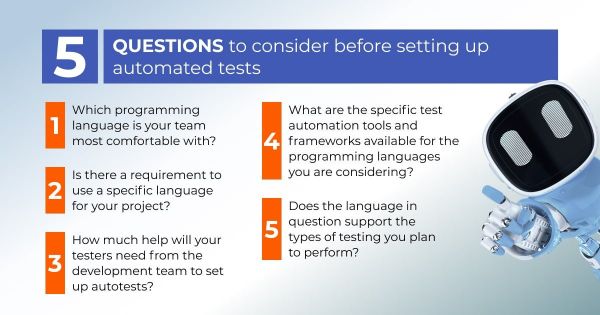In the world of software development, the question of language is not merely about choosing one's favorite or the most popular in the market. It is a strategic decision that can impact the efficiency, functionality, and scalability of a digital product. As business owners and tech teams navigate the process of code creation, from web development to automated testing, they are often puzzled by a common question: should we use the same programming language to write automated test scripts as we used for building our website? Is the convergence of web development and automation testing languages a critical factor in creating a robust and reliable web product?
The role of programming languages in web development is clear — they are the building blocks that bring our virtual structures to life. Less discussed, however, but of equal importance, is their role in automated testing. According to Stack Overflow Annual Developer Survey 2023, 60.79% of developers reported having test automation integrated into their SDLC, with JavaScript, HTML/CSS, and Python being the three most popular coding languages.
Automated tests are vital in ensuring the smooth operation of websites, catching bugs before they reach end users, and maintaining the high standards of functionality that the target audience demands. It might seem logical to suggest that the language used to create a website should also be used to automate its checks. But is that necessarily the case?
This article aims to delve into this critical question, presenting arguments for both matching the programming languages in web development and automated software checks and using different ones for these processes. As we explore the influence that this decision has, we will weigh the advantages of each approach and ultimately aim to provide a balanced and informed perspective to guide your decision-making process. Hope this piece will help you decide which strategy to follow to build a thorough automated QA process that is comfortable for your team and efficient for your software product.
Matching Languages
In this chapter, we will discuss the advantages of using the same programming language for web development and test automation.
Seamless Integration
The first significant advantage to consider is seamless integration. When you have a website and start considering setting up automated tests for it, using the same programming language generally means that you will face fewer compatibility issues.
Programming languages often have their unique syntax, characteristics, and subtleties. By using the same language, you avoid the challenge of "lost in translation" scenarios. For example, a great benefit here is the fact that your team will be able to use the same tools to check the source code and test automation scripts. This compatibility can expedite the development process, making the implementation of changes and updates to your website more efficient.

Easy Communication Between Teams
The harmonization of languages also simplifies communication between the web development team and the testing team. If everyone speaks the same 'language,' explaining code structure, functionality, and potential issues becomes a lot more straightforward. It creates an environment where each team member, regardless of their role, can understand the terminology, as well as contribute to and learn from the discussions surrounding the code. The resulting transparency can enhance overall tech team collaboration.
Efficient Error Identification and Debugging
Finding and fixing bugs is a common challenge in web development. When developers and automation QA engineers use the same programming language, detecting and resolving errors can be much more efficient.
The debugging process involves reading and understanding code to identify where things have gone wrong. If the testers are comfortable with the language because it is the same that they are using to write tests, they will be better positioned to understand the system under test.
Utilizing Existing Skills
Finally, the matching of languages allows for the optimal use of the existing skills of your tech team. For example, your tech specialists can engage in tester-developer pair programming when the developer writes the code while the tester acts as the observer, reviewing the code and thinking about potential test scenarios as it is written. This approach allows for getting the most out of your team's capabilities, leading to higher productivity and quality output.
In conclusion, matching programming languages for web development and test automation can lead to significant benefits in terms of integration, communication, error handling, and team productivity. However, this is just one side of the coin.
Practical Case, When Matching the Languages of the Sofware and Automated Tests Is the Right Approach:
Consider an e-commerce web application developed in Java. It features a complex back-end with intricate business logic, diverse product catalogs, user accounts, and transaction handling. In such a case, using Java for test automation can be beneficial because:
Complex business logic: Automated test scripts written in Java can directly call and test the services in the application, creating a more efficient and precise test script. For instance, if you have a business logic method that calculates discounts on bulk orders, you can directly call and test this method with various input scenarios using Java.
Shared skills and knowledge: The testing team can leverage the same libraries and frameworks used in development for writing tests. Developers can also contribute to writing test scripts, promoting a DevTestOps culture.
Robust testing tools: Tools like JUnit and TestNG for unit tests, and Selenium WebDriver (with Java bindings) for UI tests, provide a robust ecosystem for automation testing.
Independence of Languages
Using different languages for creating software and writing test scripts for it can offer its own advantages. Let's explore them in more detail.
Exploiting the Strengths of Specific Languages
Every programming language comes with specific strengths and weaknesses. For instance, JavaScript is prevalent in web development due to its native browser compatibility, while Python's simplicity and readability make it a popular choice for writing test scripts. By allowing the use of different languages for development and automated testing, you can exploit the strengths of each language for its respective task.
The language of the source code might not always be the most optimal option for writing test automation scripts for a particular type of software tests. Therefore, it is a must to analyze what best suits your team’s needs and the tech stack you would like to use for setting up automated testing.
Diversifying Skill Sets
By using different programming languages, tech teams can diversify their skills and approach problems from different angles. This diversity can lead to a broader understanding of programming and problem-solving, resulting in more creative and effective solutions. In addition, having proficiency in multiple languages can enhance a team's adaptability and make them better equipped to handle a wide range of projects.
Mimicking the End User's Experience
Using different languages for web development and testing can also allow for tests that replicate the end user's experience better. For example, if a website is developed in Java, but its primary users interact with it through JavaScript-enabled browsers, then writing test scripts in JavaScript could provide a more accurate representation of the user's experience with the site.
Expanded Choice of Automation Frameworks and Tools
Lastly, every programming language offers access to a different set of test automation frameworks and tools. The choice of language for test automation can sometimes be driven by the specific features, ease of use, or performance of this tech stack. For example, Selenium supports multiple languages, while other tools might be language-specific. Therefore, a different language for automated testing might give you the opportunity to utilize a tool that's ideally suited to your testing needs.
If you are still contemplating what the best approach might be, here are a few questions that can help you decide which programming language to use for test automation:

Practical Case, When Using a Different Language for Automated Tests Is the Right Approach:
Suppose you have a team of developers proficient in Ruby building a web application with this coding language. However, your QA team is more proficient in Python and has extensive experience with Python-based testing tools and frameworks. In this case, it might make more sense to use Python for writing automated tests. Here are some reasons why:
Tester proficiency: Testers would be able to write, understand, and maintain test scripts more effectively in a language they are familiar with. Python's syntax is simple and readable, which can also make the tests easier for others (like developers or new QA engineers) to understand.
Diverse testing libraries: Python has an array of powerful libraries for testing, such as Pytest for functional testing, Selenium WebDriver for browser-based testing, and Locust or JMeter for load testing. Even if your web application is built in Ruby, these Python-based tools can still effectively test your application through its external interfaces (like the user interface or APIs).
Language-independent testing: In many situations, especially for black-box testing, it doesn't matter what language the application is written in. Tests interact with the application from the outside, just like a real user or another system would. They are not concerned with the internal operations of the application. Thus, choosing a testing language that your QA engineers are comfortable with could be more important than matching it to the development language.
Balancing Factors and Making the Best Choice
To sum up our discussion, it is important to say that the choice of whether to match or diversify languages between web development and test automation is not black-and-white. Both approaches carry their unique benefits, and the decision should be influenced by a range of factors specific to your project and your team.
The nature of your website, the expertise of your team, specific project requirements, availability and suitability of test automation tools and frameworks for your chosen language, and the need to simulate the end user's experience should all be taken into account when making this decision. All in all, it is about striking a balance between these multiple details, ensuring you choose the path that leads to a robust, user-friendly, and reliable web application.
Remember, in web development and test automation, one size does not fit all, as the path to your end goal may vary from project to project. Do not hesitate to contact the team of QATestLab in case of any questions, and have a happy bug hunting!
